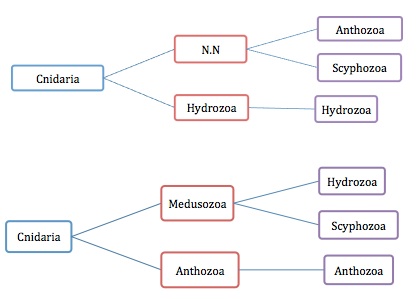Overview
Introduction
Economic Importance
Physical Description
Size
Ecology
Local Occurrence
Global Distribution
Crypsis
Life History & Behaviour
Life Cycle & Reproduction
Locomotion
Feeding (Report)
Anatomy & Physiology
Nervous System
Musculature
Respiration, Circulation & Excretion
Evolution & Systematics
Systematics
Conservation & Threats
Conservation
Threats
References |
SYSTEMATICS
Te following information is sourced from Ruppert et al., 2004.
The current accepted phylogeny of Medusozoa and Hydrozoa is shown in Figure 6.1 below.

Figure 6.1: Phylogeny of Medusozoa and Hydrozoa. Adapted from Ruppert et al., 2004. |
Medusozoa is split into two classes Scyphozoa and Hydrozoa. Scyphozoa is characterised by the presence of rhopalia, gastric filaments, solid tentacles and medusa septa. Hydrozoa is characterised by the presence of medusa vellum, bulbs at the base of tentacles and nematocysts being restricted to the epidermis. From here, Hydrozoa is split into A-forms and L-forms. A-forms are characterised by the absence of a theca, fruticose colonies arising by budding from the axial polyp and the presence of manubrial gonads. A-form jellyfish are further split into Anthoathecatae (characterised by ocelli in tentacular bulbs) and Siphonophora. L-forms are split into Leptothecatae (characterised by ectodermal statoliths) and an unidentified ancestor (characterised by a reduced polyp stage and endodermal statoliths). The unidentified ancestor is then further split into Limnomedusae and Trachylina. This phylogeny is generally accepted within the scientific community.
However, two evolutionary relationships among Cnidaria taxa exist, depending on whether morphology or morphology and molecular data is used. In Figure 6.2, the top phylogeny is based only on morphology. It demonstrates the traditional view of evolutionary relationships from primitive to derived: Hydrozoa to Scyphozoa to Anthozoa. This suggests that the biphasic lifestyle of Hydrozoans is the ancestral trait among Cnidaria. It also suggests that the absence of a medusa stage in the Anthozoans is the most derived characteristic. The bottom phylogeny is based on both morphology and molecular data. It suggests the reverse evolutionary relationship among Cnidaria: Anthozoa to Scyphozoa to Hydrozoa. In comparison, it suggests that the sexual polyp is the ancestral characteristic, with the planula larva and the medusa stage absent from the life cycle.

Figure 6.2: Competing Cnidaria phylogenies. Adapted from Ruppert et al., 2004. |
Due to Aequorea sp. being a Leptothecatae, it's position in the Medusozoa phylogeny is not debated. However due to its status as a hydrozoan, the position of Aequorea sp. in terms of Cnidaria phylogenies is still debated. |
|